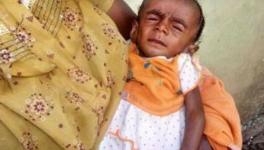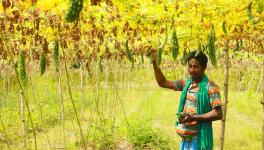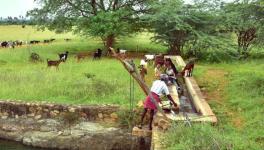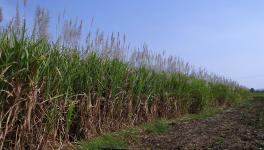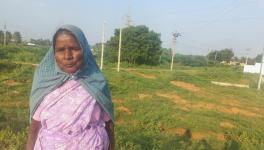TN: Huge Vacancies, Poor Infrastructure Affecting Anganwadi Work

Representational Image. Image Courtesy: Flickr
The rate of malnutrition among children and women is lower in Tamil Nadu as compared to the all-India averages, yet it is still quite high. To address malnutrition and childhood development, the Integrated Child Development Services (ICDS), a Centrally-sponsored scheme, was initiated in 1975. However, over the past 10 years, there has been a steep cut in the budget allocated for ICDS by the Central government (in real terms, the amount allocated in 2024-25 is only 59 % of the amount allocated in 2014-15).
In Tamil Nadu, there are 50,000+ anganwadi centres that cater to children in the age group of 0-6 years as also pregnant women and lactating mothers. These anganwadis cater mostly to the poor and marginalised population (for instance, while the percentage of Scheduled Castes & Scheduled Tribe) people in the general population is 21%, the percentage of people availing services from the anganwadis from these groups is 29 %).
Since coming to power in May 2021, the Dravida Munnetra Kazhagam or DMK government has introduced a few new initiatives but these have not paid attention to some significant issues that have gotten worse. Some of these issues are detailed below.
Positive Initiatives
To address the discrepancy between the National Family Health Survey (NFHS-5) survey and the monthly progress report prepared, based on data provided by anganwadi workers, the Tamil Nadu government did a special survey to find out the percentage of malnourished children. A total of 37.7 lakh children were screened (the total number of children receiving benefit in the anganwadis is 25 lakh) in April 2022.
The screening found that 9.3 lakh of the children were malnourished, which is 25% of the screened population. This number is closer to the values reported in the NFHS-5 survey. Among this 9.3 lakh, it was found out that 10% of the children were severely malnourished. Using RBSK (Rashtriya Bal Suraksha Karyakram under the National Health Mission) doctors, this group was screened further and 43,000 from among the severely malnourished children were referred for special medical treatment.
To address malnutrition, the state government decided to increase the number of eggs provided for children in the age group 1–2 years from one egg a week to three eggs a week from November 2022.
Previously, the same take-home rations were given to all the beneficiaries. Starting March 2023, three types of sathumaavu (take-home rations) with different nutrition content are provided for different groups of beneficiaries (6 months - 2 years, 2 years to 6 years, pregnant women and lactating mothers).
For pregnant women and lactating mothers, the sugar content in the rations has been reduced while the protein content has been increased. These take-home rations have been prepared as per Bureau of Indian Standards, though the quantity of rations provided has been reduced as compared to earlier.
Starting June 2023, the severely malnourished children are being provided nutritious biscuits in addition to the take-home rations.
Areas of Concern: Anganwadi Closure
In April 2021, there were 54,439 anganwadis in operation in Tamil Nadu, but in April 2023, the number of anganwadis was only 54,079. A total of 360 anganwadis have been closed.
While it might be necessary to close anganwadis which serve very few children, it is also important to open anganwadis in many under-served areas. For instance, there are not enough anganwadis in many slums in cities due to lack of space. In such areas, mini anganwadis could be opened. The amount of money allocated for renting a place is too low, which is proving to be one of the barriers in opening new anganwadis.
Staff Vacancies
In May 2021, when M.K. Stalin became Chief Minister, the number of vacancies among the anganwadi workers and helpers was 14,649 (14.4%). Two years later, in May 2023, the number of vacancies increased to 18,087 (17.8%).
When an anganwadi helper position is vacant, the anganwadi worker at the centre has to do the work of the helper as well, which includes cleaning the centre, preparing hot-cooked meals, washing plates, providing take-home rations etc. This becomes a significant burden on the worker and most often, she is unable to focus on her regular work of providing pre-school education to children or provide the mandated health services.
When an anganwadi worker’s position is vacant in a centre, usually a worker from another centre is asked to do the work. Since she cannot be in two places at the same time, this means that the worker visits the centre once or twice for a few hours and maintains the registers. In such centres, it is the anganwadi helper who provides supplementary nutrition, but the children are deprived of any pre-school education or other health services.
In both such cases, the quality of services provided to children takes a severe hit. This could have severe long-term consequences for these children and for the state, too. Assuming that an anganwadi caters to 20 children, the total number of children who are provided poor service in the state is 3.6 lakh, which is a huge number.
In research supported by the Tamil Nadu government, it was reported that the quality of services provided in an anganwadi can be significantly improved if an additional person is appointed (in addition to anganwadi worker and helper). The research points to the importance of ensuring all vacancies are filled.
There is no reason why Tamil Nadu should not fill up these vacancies. If all the vacancies are filled, the total pay increase would be only Rs 175 crore a year, which is a small amount considering the government budget.
There are lakhs of women looking for work, as can be seen from the number of women who come for MGNREGS (the Central rural job guarantee scheme) work. In 2023-24, this number was 65 lakh women. Many of these women would be eligible to be appointed as anganwadi workers or helpers. Filling these vacancies, therefore, is the first step to ensuring that every child coming to an anganwadi is provided minimum services.
Decrease in Number of Beneficiaries
The closure of anganwadi centres and unfilled staff vacancies could have played an important role in the 6% reduction in the number of beneficiaries. As per the policy note documents seen by this writer, the number of beneficiaries has declined from 34 lakh in 2021-22 to 32 lakh in 2023-24.
Poor Infrastructure
The condition of many anganwadis in Tamil Nadu is very poor. As per the 2023 April Monthly Progress Report, there are a total of 9,414 anganwadis that require a new building and 5,045 anganwadi centres that require major repairs. The number of anganwadis requiring new buildings or major repair is 14,459 (26.7 %). Against this requirement, the number of anganwadis being constructed is only 1,641 (3%).
Recently, parts of the roof of an anganwadi centre in Madurai district fell down injuring the anganwadi worker and a child, both of whom were admitted to a hospital. Lack of water and toilets is also a common complaint. Many Chennai Councillors have time and again highlighted the poor condition of the anganwadis.
Lack of Community Monitoring
In August last year, the state chief secretary issued an order to all collectors to visit anganwadis and monitor their functioning. While the focus on anganwadis is welcome, it is not clear how this will be effective when each district, on average, has 1,300 anganwadis. What is required is community monitoring (through the Anganwadi-level Monitoring and Support Committee which is not functional) and social audits, as mandated by the National Food Security Act. However, this is not done.
Tamil Nadu could follow the example of Kerala and grade all anganwadis on different parameters and set specific targets for improvement.
Data Entry Burden
In recent years, anganwadi workers have been asked to enter individual data of all beneficiaries in online applications developed by both the Central and state governments. Entering data with poor network connections, faulty applications and old phones places a significant burden on these workers. Moreover, online data entry has not obviated the necessity of maintaining physical registers. Due to this task duplication, anganwadi workers are not able to spend as much time with children and do community outreach activities, as they did before.
Workers Issues
Anganwadi workers have been protesting in many districts, demanding that vacancies be filled, they be paid a regular salary rather than honorarium and be given an assured pension. The other demands are they should not be overburdened with other department work, their data entry burden should be reduced, they should not be subjected to enormous work pressure (which led to the alleged suicide of a worker in Madurai) and full payment for LPG (cooking gas) cylinders. They have also protested against budgetary cuts by the Central government.
To ensure that anganwadis continue to provide a strong foundation for the health and education of children, it is essential that the government address these issues. Hopefully, sufficient funds will be provided in the upcoming Tamil Nadu budget for this task.
Karuna M. is an independent researcher and activist based in Tamil Nadu. The views are personal.
Get the latest reports & analysis with people's perspective on Protests, movements & deep analytical videos, discussions of the current affairs in your Telegram app. Subscribe to NewsClick's Telegram channel & get Real-Time updates on stories, as they get published on our website.












